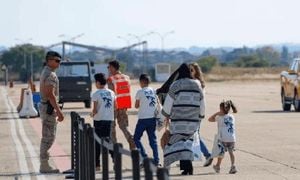On November 24, 2025, the city of Hat Yai in Songkhla province found itself in the grip of a devastating flood, the likes of which hadn’t been seen in 15 years. As relentless rains battered southern Thailand, the crisis quickly escalated, leaving entire neighborhoods submerged, residents stranded, and emergency services stretched to their limits. According to reporting from Kom Chad Luek, the Meteorological Department had warned that the heavy rainfall and thunderstorms would continue through November 25, urging citizens to brace for worsening conditions.
For many, the warnings came too late. In Hat Yai, the flooding was so severe that several communities, especially those in low-lying areas, became isolated overnight. Among the most harrowing stories was that of an elderly couple, both 70 years old, who found themselves trapped in their home for three days without access to food, drinking water, electricity, or even a working phone. Their daughter, desperate to get help, took to social media to sound the alarm, posting their address and contact information in hopes that someone—anyone—would respond.
“My parents have been stuck inside their house for three days now,” she wrote, as reported by Kantana Kuerchart on Facebook. “They have run out of drinking water, food is almost gone, there’s no running water, no electricity, and their phone battery is dead. They both have chronic asthma and can’t walk well due to recent knee surgeries. I have contacted several agencies, both official and volunteer, but so far, no one has come to help.” The post included their location—house number 101, Soi 15, Rat-Uthit Road, adjacent to a Christian church in Hat Yai—and a phone number for urgent coordination. “I hope someone, anyone, can bring a boat or a high vehicle to help evacuate them as soon as possible,” she pleaded. “Their physical condition is weakening, and they lack the basic necessities to survive.”
This wasn’t an isolated plea. Across Songkhla, and particularly in Hat Yai, residents inundated emergency lines and social media with requests for help. Kom Chad Luek reported that the local government and disaster response teams were overwhelmed by the sheer number of people needing evacuation. The floodwaters rose rapidly, cutting off roads and making many areas inaccessible, even for rescue teams equipped with boats and high-clearance vehicles.
The Meteorological Department’s warnings proved prescient. The heavy downpour, part of a larger weather system sweeping across southern Thailand, not only caused the catastrophic flooding in Songkhla but also battered Bangkok and surrounding provinces. In Bangkok’s Nong Khaem district, the combination of torrential rain and hazardous weather conditions may have contributed to a major fire at a plastic products factory on Soi Phetkasem 81. According to reports, the fire broke out on November 24 and quickly spread due to the abundance of flammable materials on-site. Firefighters battled the blaze for three hours before finally bringing it under control, but not before damage soared past 70 million baht. Fortunately, no casualties were reported.
Back in Hat Yai, the situation grew increasingly dire as the hours ticked by. Anutin Charnvirakul, Thailand’s Prime Minister and Minister of the Interior, acknowledged the gravity of the crisis. “The situation is worse than expected,” he told reporters, as cited by Kom Chad Luek. “There is a massive influx of water into the city, making many areas inaccessible and making rescue operations extremely challenging.” The government’s response included a list of emergency contact numbers for all 16 districts in Songkhla, but even with these resources, the sheer scale of the disaster made it nearly impossible to reach everyone in need in time.
For the elderly couple and countless others, the lack of immediate assistance was a matter of life and death. Their daughter’s account highlighted the vulnerability of those with chronic health conditions and limited mobility. “They can’t wade through the floodwaters on their own,” she explained. “They’re completely dependent on outside help.” Her story resonated with many in the community, sparking a wave of solidarity and prompting volunteers to mobilize where official efforts fell short.
As the floodwaters continued to rise, the city’s infrastructure buckled under the strain. Power outages were widespread, and the loss of running water compounded the misery for those stuck indoors. Emergency services urged residents to conserve supplies, stay on upper floors, and avoid unnecessary risks. Yet, as the hours dragged on, hope began to wane for those still waiting for rescue.
The broader context was no less grim. The Meteorological Department’s forecast indicated that the heavy rain would persist at least until November 25, raising fears that the flooding could worsen before any relief arrived. In Hat Yai, the flood was already being described as the worst since 2010, when the city last experienced a disaster of this magnitude. The memory of that event—when thousands were displaced and the local economy took years to recover—hung heavy over the current crisis.
Despite the daunting circumstances, there were glimmers of hope. Community groups, local volunteers, and even strangers responded to calls for help, using boats and makeshift rafts to reach those stranded in their homes. Social media became a lifeline, connecting people in need with those able to assist. The story of the elderly couple, amplified online, eventually reached the right ears, and a rescue team was dispatched to their location. Their safe evacuation was a rare moment of relief in an otherwise bleak situation.
Meanwhile, the authorities continued to monitor the weather closely, warning residents to remain vigilant. “We urge everyone to stay informed and follow official updates,” the Meteorological Department advised. “The risk of further flooding remains high, especially in areas downstream from Hat Yai.” Emergency hotlines were circulated widely, and local radio stations provided real-time updates on road closures, evacuation centers, and relief efforts.
The crisis in Hat Yai and the surrounding region served as a stark reminder of the power of nature—and the importance of preparedness. While the government’s response faced criticism for delays and logistical challenges, the resilience and solidarity of ordinary citizens shone through. As the floodwaters slowly began to recede, attention turned to the daunting task of recovery and rebuilding. For many, the scars of this disaster would linger long after the rain had stopped.
In the end, the events of November 24, 2025, will be remembered not just for the devastation they wrought, but for the extraordinary courage and compassion displayed by those who stepped up when it mattered most.




